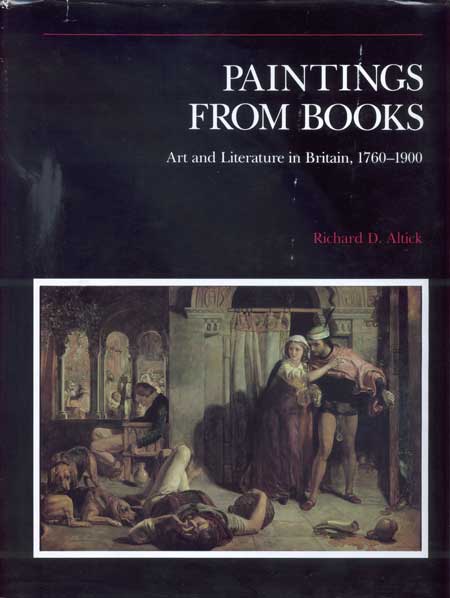| < | leave / read comments and critiques of the book |

Paintings from Books
Art and Literature in Britain, 1760–1900
Richard D. Altick
Breaking new ground in the study of British painting and literature, Richard D. Altick reveals in this informative and richly illustrated volume how the literary taste of the day was reflected, sometimes controversially, on the walls of London’s annual art exhibitions. Armed with catalogues that were miniature anthologies of poetic extracts, gallery-goers looked at prominent artists’ versions of their favorite characters and scenes in poetry, fiction, and the drama, and judged them according to the preconceptions already formed in their mind’s eye. Beginning in Hogarth’s time and the first years of the Royal Academy and lasting down to the end of Victoria’s reign, paintings with subjects from English literature—some twelve thousand are recorded—reaffirmed in a new context the ancient belief in the sisterhood of the arts.
In the early years, when the lofty goal of history painting in the grand style beckoned ambitious artists, they drew their subjects mainly from Shakespeare, Milton, and Spenser. Later, as the affluent middle-class market for household art grew, and with it the demand for congenial literary subjects, Burns, Scott, Byron, and Tennyson joined the company of most-painted authors. From the Lady of Shalott and the nude Musidora in Thomson’s The Seasons to the fallen angels in Paradise Lost and domestic genre scenes from Goldsmith’s The Vicar of Wakefield, British art served for more than a century and a half as a comprehensive mirror of the currents and eddies of literary taste.
The developments traced in this book, which is based on an exhaustive study of the graphic and printed annals of British art and the records of individual authors’ fame, makes it clear that we can say of literary pictures what Henry James once said of English art in particular: “English painting interests me chiefly, not as painting, but as English. It throws little light, on the whole, on the art of Titian and Rembrandt; but it throws a light which is to me always fresh, always abundant, always fortunate, on the turn of the English mind.”
Following the dozen chapters that constitute the narrative portion of the book, Parts Two and Three comprise a convenient guide to the art histories of each of Shakespeare’s plays and the works of some thirty other authors. A finding-list of reproductions of literary paintings and a large bibliography enhance the book’s value to readers interested in learning more about this hitherto neglected subject.
Richard D. Altick is Regents’ Professor of English, Emeritus, at The Ohio State University. He is the author of
The Scholar Adventurers,
The English Common Reader, Lives and Letters, To Be in England, Victorian Studies in Scarlet, Victorian People and Ideas, The Shows of London, and numerous other books and essays on English literature and culture.
| 1985 527 pp. 356 illustrations | |

